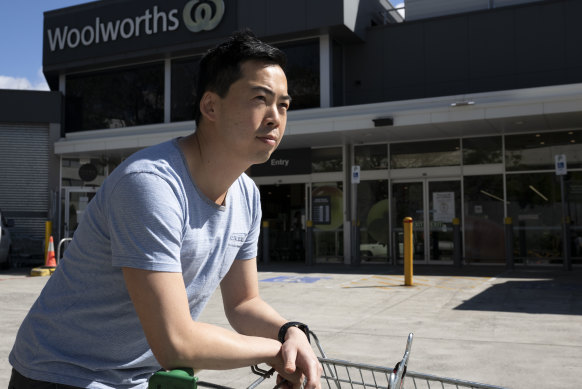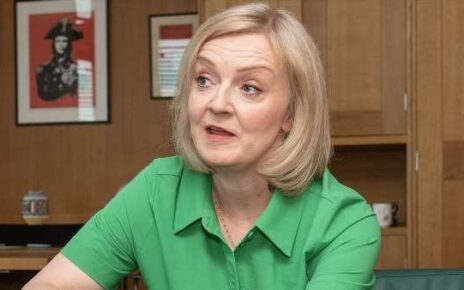Save articles for later
Add articles to your saved list and come back to them any time.
Woolworths Metro representatives have promised prices will not increase as stores in Sydney’s inner west are converted into convenience-style Metro formats with an expanded selection of convenience products and ready-to-go meals.
Residents have protested against the conversion of full Woolworths supermarkets in Balmain and Alexandria to Metro-branded outlets, saying the changes will add too much pressure to household budgets amid the cost of living crisis.
Sydney Lord Mayor Clover Moore earlier this month wrote to Woolworths chief executive Brad Banducci urging him to reconsider converting the stores on Fountain Street, Alexandria and Darling Street, Balmain, saying residents could be impacted by higher prices.
Andrew Wong outside his local Woolworths in Alexandria, Sydney, which is set to become a Metro store, angering residents.Credit: Janie Barrett
The Sun-Herald analysed the cost of three dozen common items at nine Woolworths supermarkets across Sydney’s inner city and found price differences on a number of products.
A Quilton three-ply eight-pack of toilet paper costs $8.60 at Woolworths stores in Alexandria, Mascot and Redfern, $9.05 at Metros in Erskineville, Park Sydney, Green Square and North Sydney, and $9.90 at Redfern Station Metro.
Customers also pay 40 cents more for a 495ml bottle of Fairy dishwashing liquid; 35 cents more for a 765-gram pack of NutriGrain; 25 cents more for Dairy Farmers two-litre milk bottles and 20 cents more for Pace Farm free-range jumbo eggs at Metro stores.
There was also a $5 price difference between a 900-gram tin of Aptamil Gold Stage One baby formula between some Metro and Woolworths stores, an increase of 16 per cent.
Woolworths branded full cream two-litre milk also costs $3.10 in Woolworths Alexandria, Mascot and Redfern, though $3.30 at Metro Erskineville, Park Sydney, Green Square and North Sydney and $3.45 at Redfern Station Metro.
After being contacted by The Sun-Herald, a Metro spokesperson acknowledged the price difference of the company’s own milk brand products was due to an error, which has since been rectified.
Catalogue specials were honoured across stores.
A Metro spokesperson said there was no one-size-fits-all approach for Metro stores and prices differed between smaller stores, such as Erskineville and Redfern station, which have higher costs to operate.
“Overall, Metro pricing remains very competitive against local competition, whether that be other convenience players in the inner city or supermarkets in suburban locations of our neighbourhood stores,” the spokesperson said.
“There’s no change to the pricing approach as a result of the conversion in this or other supermarkets that have recently joined Metro with ongoing alignment to supermarket pricing as these stores fit the larger store size for Metro.”
The proportion of Metro-branded stores has doubled in the past five years, making up 8.2 per cent of all Woolworths stores, compared with 3.2 per cent in 2018.
Alexandria resident Matthew Denby said he wasn’t just worried about price differences, but the lack of range.
“I want to be able to go into Woolworths get a normal weekly shop and not be bothered about having to go trek all over town to find [items],” he said.
“We’re hemmed in around here by three Woolworths Metros in the immediate area, so there’s no alternative for us.”
Moore said she was pleased Woolworths is listening to the community after representatives attended a community meeting at Alexandria Town Hall on Wednesday, but said there was a long way to go to rebuild trust.
“We are in a cost-of-living crisis and the community is rightly concerned about any changes to their local grocery stores,” she said.
“The bigger issues are how long prices will remain consistent with full-service Woolworths stores and whether the supermarket will commit to making prices transparent between all stores, irrespective of location.”
Retail analyst, former head of price strategy at Woolworths and founder of retail analyst software company ShopGrok Aaron Cowper said Woolworths was likely trying to compete with convenience stores in the area, such as 7/11s and smaller IGAs.
“They’d be trying to increase profitability where they can, but it also has to do with the size of the store and range,” he said.
Cowper stressed Woolworths would be in constant negotiations with supplies to try to keep prices low: “It’s a constant balancing act and if they were to push prices too high, it would come back to bite them. Once you lose customer trust, you lose it quickly, and it’s hard to regain it.”
Most Viewed in National
From our partners
Source: Read Full Article



